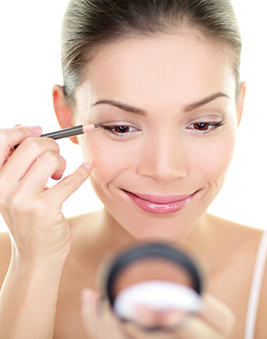
Rude Looks
Naturally beautiful make-up
What’s the difference between conventional make-up and the more natural versions? Read on to find out
Spot the difference
According to Niamh Larkin, Senior Beauty Advisor at Evergreen Healthfoods, Mainguard St, Galway, “conventional make-up contains ingredients such as petroleum, paraffin and lead. Natural make-up consists of much milder ingredients that are kinder to the skin and the environment. Because 60% of what we wear on our skin gets absorbed, harsh ingredients take a toll, not only on the skin but also on our livers.”
Rebecca Goodyear is a natural lifestyle expert who writes an award-winning blog, Biteable Beauty. “When buying natural or mineral make-up you can be sure that the products are purer and less irritating to the skin and contain no ingredients that may be detrimental to health such as carcinogens, hormone disruptors and irritants,” she says. “They are usually non-comedogenic which means they won’t clog pores and are free from perfumes, talc, alcohol, dyes, mineral oil or preservatives, all potential skin irritants.”
What's in natural make-up?
“Natural make-up contains ingredients such as shea butter, coconut oil and olive oil for moisturising,” says Niamh Larkin. “Essential oils are often chosen for their moisturising properties and ability to smooth and soothe the skin. Calendula extract, for example, protects the skin and acts as a barrier and rose extract is use as a skin softener.
“Natural make-up has a lot of the same ingredients as natural moisturisers, meaning that they keep the skin hydrated while providing coverage. Conventional make-up can leave the skin dry and prone to blemishes and other imperfections.”
According to Rebecca Goodyear, “natural make-up allows the skin to breathe and may even contain cosmeceutical ingredients, i.e. ingredients that are beneficial to skin health.”
She says there are three main ingredients when it comes to mineral make-up:
- coverage minerals – zinc oxide and titanium dioxide; these have anti-inflammatory properties, may help with skin conditions including rosacea, and depending on the concentration of the two minerals may offer a sun protection factor (SPF).
- adhesion mineral – sericite mica; mica is a mineral that helps to provide cover-up, reducing the appearance of pores and fine lines and wrinkles.
- colour minerals – iron oxides; provides the colour of the make-up.
Other ingredients used in natural make-up may include natural oils, butters and kaolin clay to help achieve the desired consistency, texture and staying power.
Staying power
Does natural make-up last as long as conventional products?
“Absolutely!” says Rebecca Goodyear. “Mineral make-up has come on leaps and bounds in recent years in terms of formulation as well as the selection of colours. All good things come to those who wait and as the natural beauty industry is advancing, so too are the formulas.”
“We stock two brands of natural make-up, one of which just re-launched their entire makeup range, introducing six new shades of foundation with a ‘10 hour lasting’ sticker on the front,” says Niamh Larkin. “So far we are receiving positive feedback from our customers on one range. The other range is one I use myself and I love that I only need to apply it once a day for full coverage.”
Changing trends
“People are gradually waking up to the benefits of natural and organic ingredients and products, make-up included,” says Rebecca Goodyear. “Natural beauty products are also starting to appear in more mainstream beauty features in magazines and newspapers and there are more emerging green celebrity ambassadors who promote natural living such as Miranda Kerr, Gwyneth Paltrow, Natalie Portman and Gisele Bundchen.”
“Sales of natural make-up are definitely on the rise as people are becoming more aware of harmful ingredients, and more people are suffering allergic reactions to conventional make-up and its ingredients,” says Niamh Larkin. “Also, natural make-up is often cheaper than some of the more conventional leading brands.”
Click here to read other Rude Looks articles.
Click here to return to the Rude Health Magazine homepage.